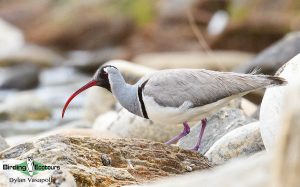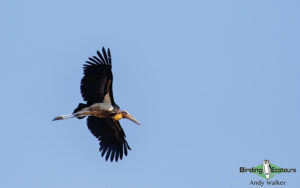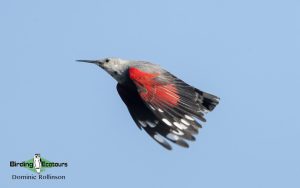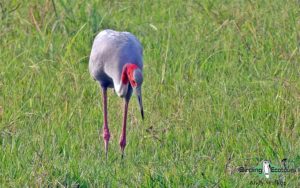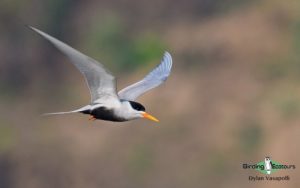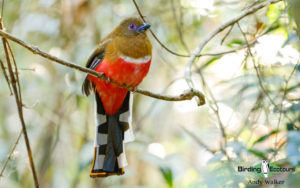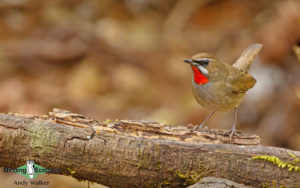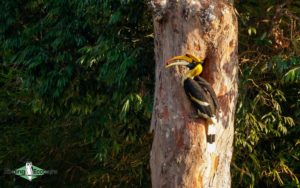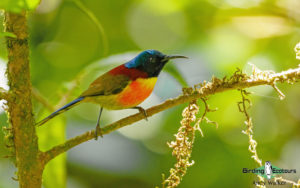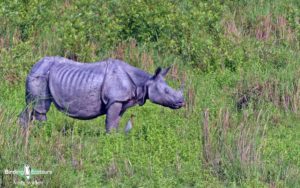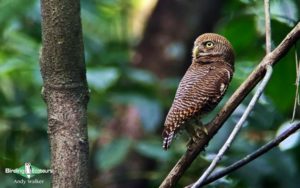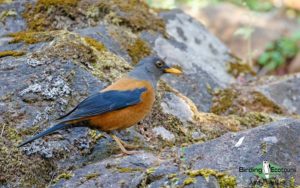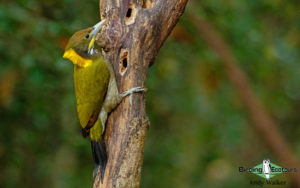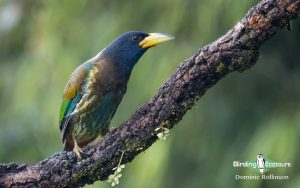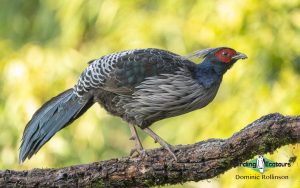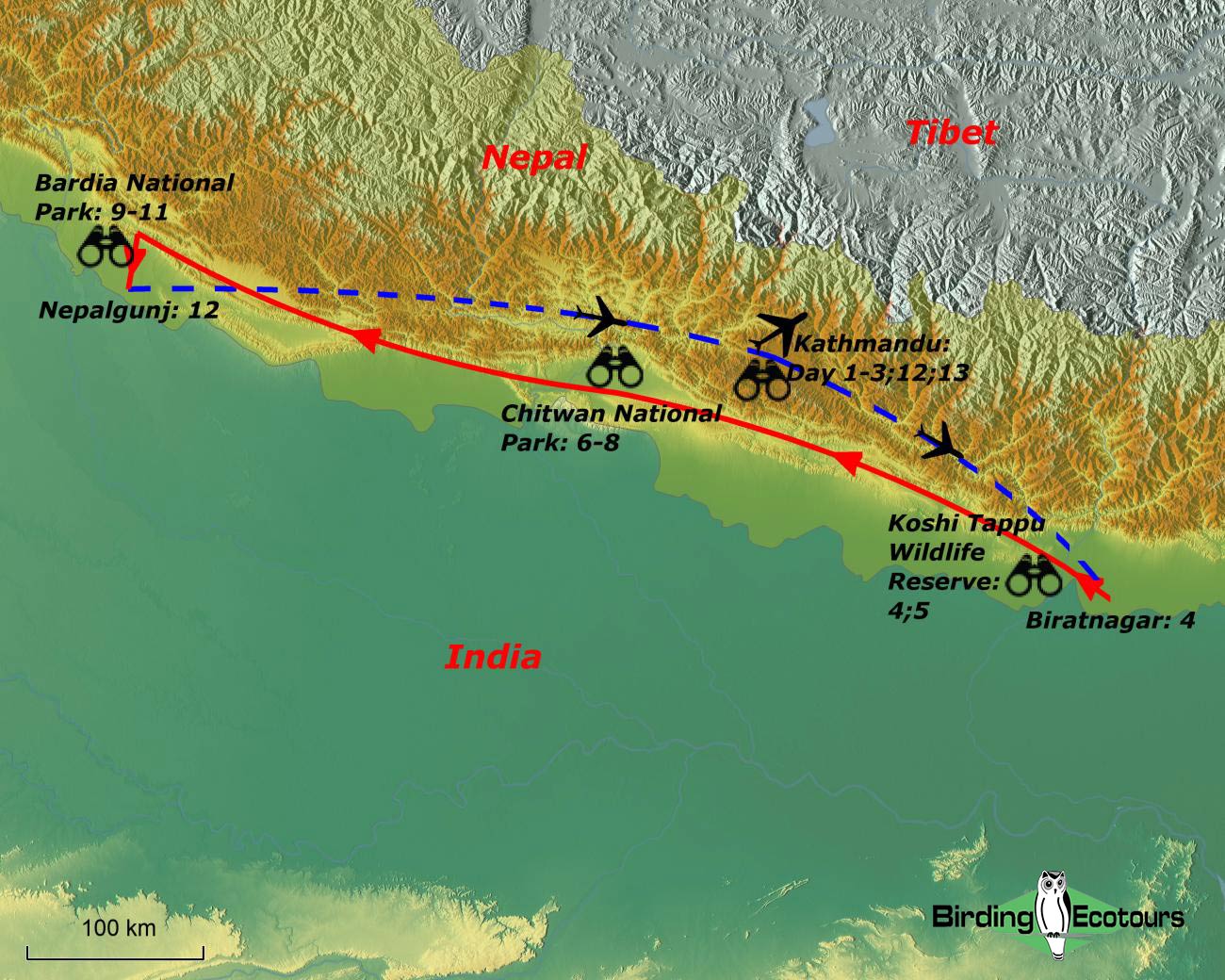Birding Tour Nepal: Easy Himalayan Birding
Birding Tour Nepal: Easy Himalayan Birding
March 2026/2027
This exciting and easy birdwatching tour offers the opportunity to experience the immensity of birding the world’s highest mountain range in some of the most spectacular scenery on the planet as part of a small group of fellow birdwatchers, wildlife enthusiasts, and nature lovers.
The former kingdom of Nepal, now officially the Federal Democratic Republic of Nepal, is a land-locked country in Asia and one of the most mountainous on the planet. It is located in the central Himalayas, and of the world’s ten highest mountains eight are in Nepal! This country was cut off from the outside world for many decades after the Second World War, but now it has opened up its boundaries to travelers, and it is definitely worth exploring.
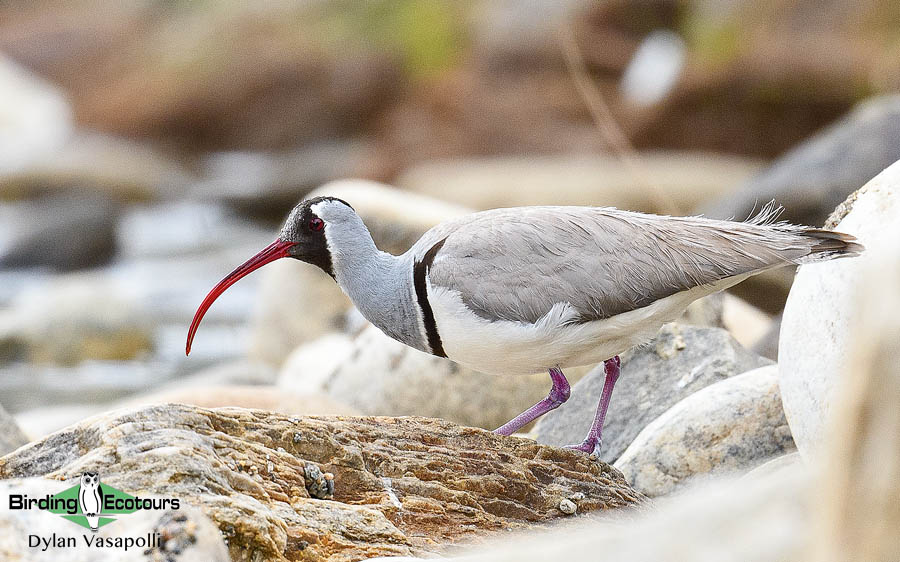 The monotypic Ibisbill can be found on the fast-flowing rivers in Nepal.
The monotypic Ibisbill can be found on the fast-flowing rivers in Nepal.
Nepal boasts a spectacular diversity of habitats from the lush lowlands of the Terai (“moist land”), conserved in the famous Chitwan National Park, to the top of Mount Everest! This remarkable heterogeneity of different habitats in such a small country means that Nepal boasts a bird list of over 900 species in a country less than half the size of Germany (i.e., a similar size to the US state of Arkansas).
Our itinerary is designed to maximize your exposure to the different habitats and incredible birds Nepal has to offer without trekking on foot for days into the higher Himalayas (though we can arrange trekking after your tour as an extension should you wish to explore some areas on foot). We will target the sole Nepalese endemic, Spiny Babbler, as well as two monotypic families with the highly-sought duo of Ibisbill and Wallcreeper along with further exciting avian possibilities including Indian Courser, Swamp Francolin, Lesser Adjutant, Sarus Crane, Black-bellied Tern, White-tailed Stonechat, Himalayan Rubythroat, Indian Grassbird, Bristled Grassbird, Rufous-vented Grass Babbler, Nepal Fulvetta, Himalayan Cutia, and Tibetan Serin, along with a large list of other birds.
The areas we will be visiting on the tour have historically held both Bengal Florican and Lesser Florican, though both species have dramatically declined in their numbers in recent years and although the chance of seeing any floricans is very low and not to be expected on this tour, we will of course be keeping our eyes peeled for them and hoping to get lucky.
Non-avian highlights during our tour could include sightings from the magnificent selection of Greater One-horned (Indian) Rhinoceros, Bengal Tiger, Ganges River Dolphin, Asian Elephant, Indian Leopard (Panthera pardus fusca), Fishing Cat, and Wild Water Buffalo.
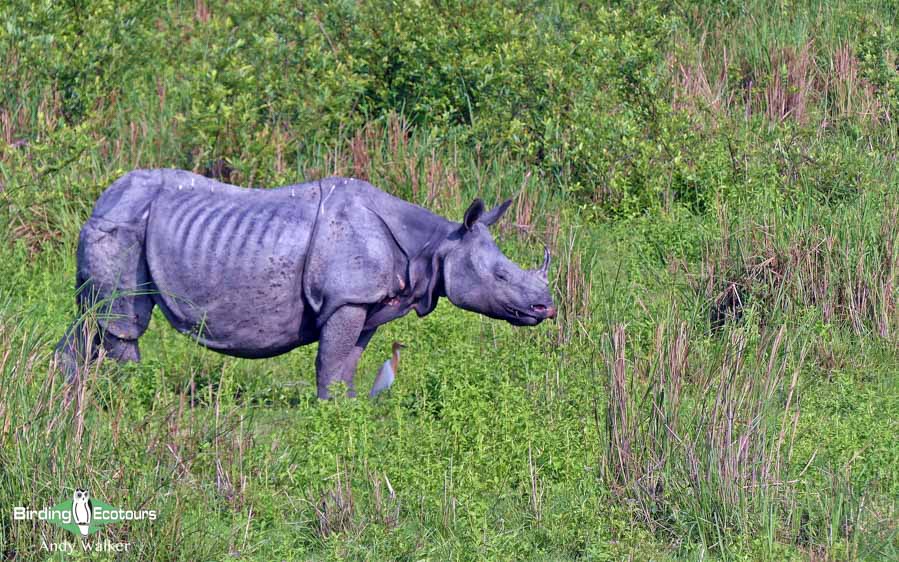
Throw together the aforementioned amazing wildlife, great food, incredibly friendly people, a highly interesting culture, and some of the best scenery on the planet (don’t forget your camera!), and a great tour will be had by all.
If you would like to extend your birding in this part of Asia you could join our Birding Tour India: The Northeast – Spectacular Birds and Mammals (after this tour), which offers mouth-watering species such as Ward’s Trogon, Spotted Elachura, Bugun Liocichla, Beautiful Nuthatch, Rufous-necked Hornbill, Fire-tailed Myzornis, White-winged Duck, Temminck’s Tragopan, Blyth’s Tragopan, and Himalayan Monal.
Itinerary (13 days/12 nights)
Day 1. Arrival in Kathmandu
There will be time at leisure after your arrival at Tribhuvan International Airport in Kathmandu. You will transfer to our comfortable hotel in the city, and we will meet for a group evening meal together. If you arrive early in the day, or even a day or two earlier, we can arrange for an optional extra guided tour of this ancient and fabled city. Kathmandu boasts some of the most impressive Buddhist temples on the planet (e.g. Swayambhunath temple complex), and Buddha himself was actually born in Nepal, so something pretty special and worthwhile to experience.
Overnight: Kathmandu
Days 2 – 3. Shivapuri Nagarjun National Park, Phulchowki, and Godavari
We will have two days birding within and around the Kathmandu Valley as we acclimatize to the area from our base in Kathmandu. We will spend time birding around Shivapuri Nagarjun National Park, Phulchowki, the highest of the hills surrounding the Kathmandu area at 2,800 meters (9,185 feet), and the nearby Godavari Botanical Garden. All are beautiful spots with luscious gardens and forests. The Shivapuri Nagarjun and Phulchowki areas provide us with an opportunity to see a wide diversity of central Himalayan mountain specialties and some fantastic and classic Himalayan views. The highly enigmatic and colorful Himalayan Cutia is one of our main targets over these two days, but with luck we may also find Golden-naped Finch, Tibetan Serin, Maroon-backed Accentor, or the rare and local endemic Spiny Babbler.
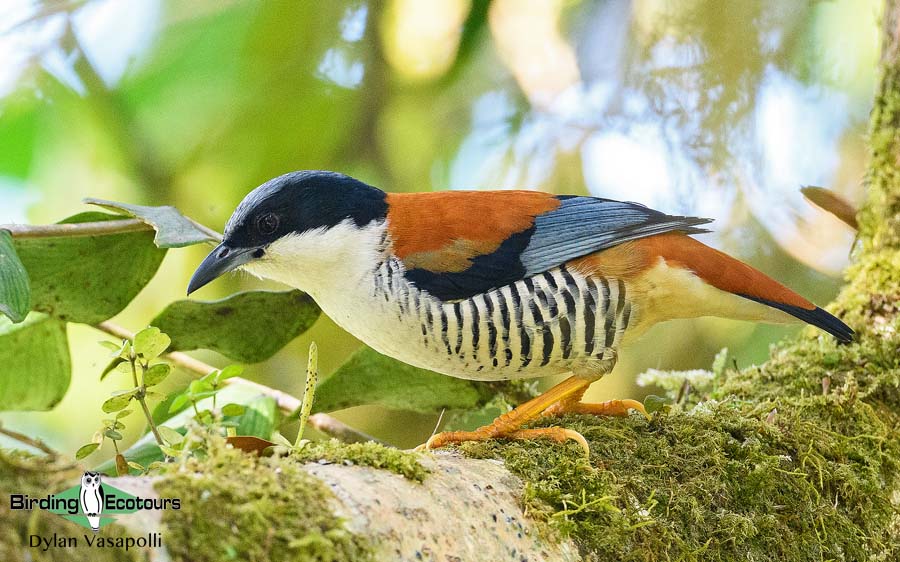
Other species that we will search for include the aptly named Hoary-throated Barwing, the kaleidoscopic Bar-throated Minla, and the dazzling Scarlet Minivet. Laughingthrushes abound, and we will hope to see Striated Laughingthrush, Streaked Laughingthrush, Grey-sided Laughingthrush, Rufous-chinned Laughingthrush, Chestnut-crowned Laughingthrush, and White-throated Laughingthrush. Other central-Himalayan specialties include Darjeeling Woodpecker, Rufous-breasted Accentor, Rufous-vented Yuhina, Stripe-throated Yuhina, Whiskered Yuhina, White-tailed Nuthatch, Nepal Fulvetta, White-browed Fulvetta, Rufous-winged Fulvetta, and a host of warblers, which includes the colorful Chestnut-crowned Warbler, Black-faced Warbler, and Ashy-throated Warbler. Barbets are numerous here and include Great Barbet and Golden-throated Barbet. With some luck and patience we may get good views of the remarkable Chestnut-headed Tesia or the skulking Himalayan Shortwing (formerly called White-browed Shortwing prior to that complex getting split), while flowering trees may attract the stunning trio of Fire-tailed Sunbird, Green-tailed Sunbird, and Black-throated Sunbird. We will also keep our eyes firmly peeled on any shady watercourses for the stunning Spotted Forktail and Blue Whistling Thrush.
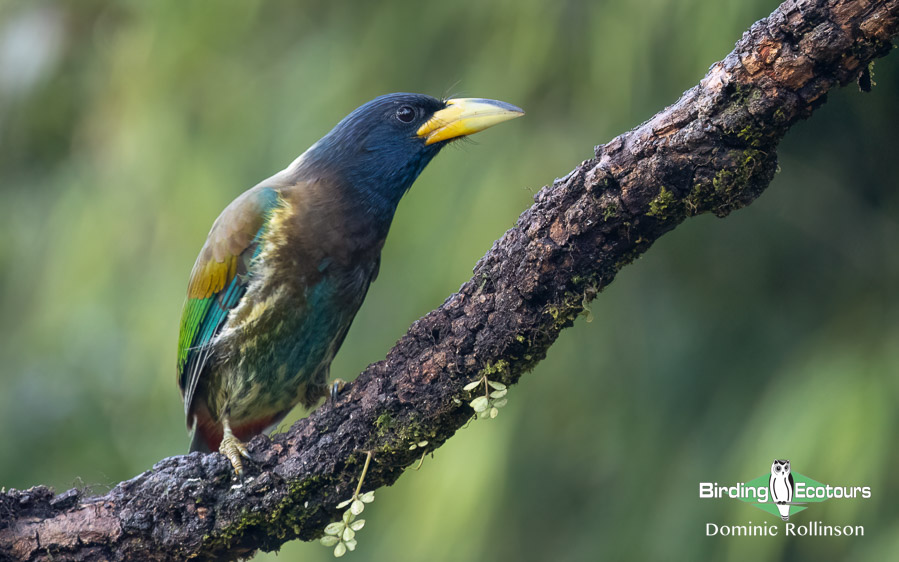
In the Godavari Botanical Garden we can often find Asian Barred Owlet, Black-chinned Babbler, Small Niltava, Rufous-bellied Niltava, Grey-backed Shrike, Blue-fronted Redstart, Grey Treepie, Scaly Thrush, and Grey Bush Chat.
There are many birds for us to look for here across the range of elevations, such as Kalij Pheasant, Speckled Piculet, Rufous-bellied Woodpecker, Bay Woodpecker, White-collared Blackbird, Grey-winged Blackbird, Chestnut Thrush, Hodgson’s Redstart, Golden Bush Robin, Black-throated Parrotbill, Orange-bellied Leafbird, Red-billed Leiothrix, Rufous Sibia, Maroon Oriole, Scaly-breasted Cupwing (formerly called Scaly-breasted Wren-Babbler), and Red-billed Blue Magpie. There will certainly be some magnificent birds to enjoy during our time here.
Overnight: Kathmandu
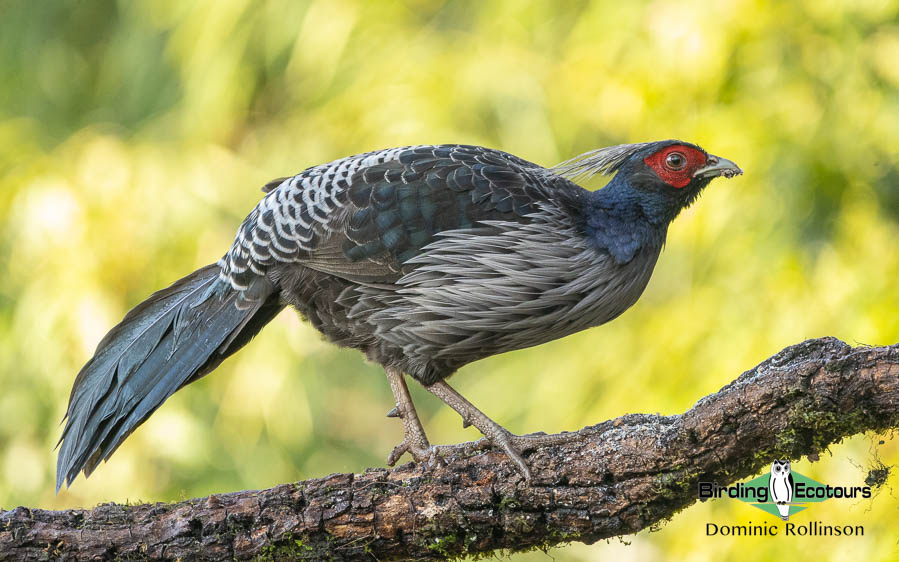
Day 4. Flight to Biratnagar, drive to Koshi Tappu Wildlife Reserve
Today we will fly to Biratnagar in the southeast of Nepal, and we will keep an eye out for Mount Everest on the way! Once landed we will immediately travel across to the nearby Koshi Tappu Wildlife Reserve. This reserve is situated in the eastern Terai of Nepal and protects an extensive area of wetlands and grassland along the floodplains of the Saptakoshi River. Koshi Tappu was declared a Ramsar site in 1976 and is home to the last surviving population of Wild Water Buffalo in the country. We will make a start on the birding in the afternoon, time permitting.
Overnight: Koshi Tappu
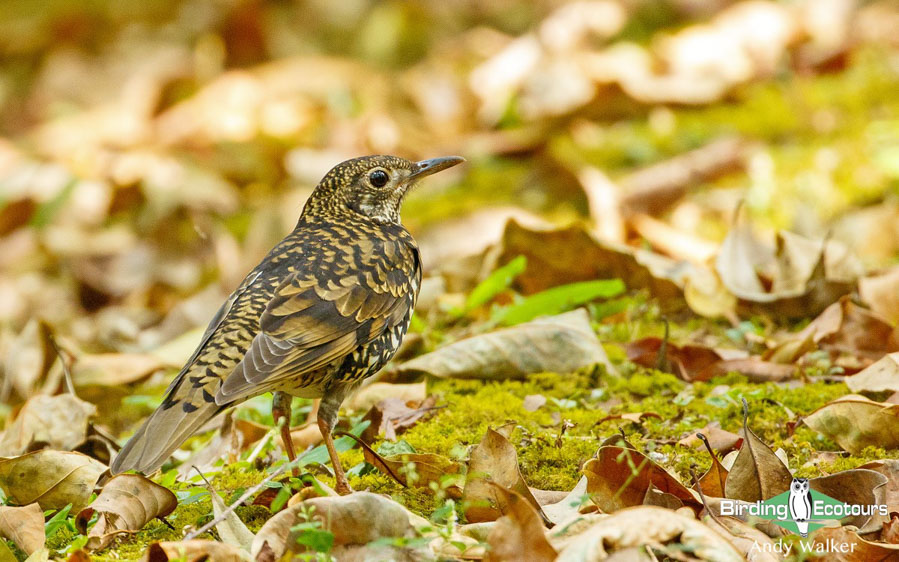
Day 5. Koshi Tappu Wildlife Reserve
The exciting wetlands, grasslands, and scrublands around Koshi Tappu are home to an impressive array of species. The reeds of the wetland habitats hold species such as Cinnamon Bittern, Black Bittern, Ruddy-breasted Crake, and Greater Painted-snipe. The threatened Swamp Francolin may be seen scuttling through the tall grasslands, and here we will also look for White-tailed Stonechat, Striated Grassbird, Citrine Wagtail, and Rosy Pipit, among many others, which include the blood-red Red Avadavat, the spectacular Siberian Rubythroat, and the cryptic Rufous-vented Grass Babbler (formerly called Rufous-vented Prinia until a recent taxonomic update). Koshi Tappu is the only location in the world where the Nepalese-endemic subspecies of the grass babbler is known to occur, so this is a big target and another potential split – the other subspecies in the complex occurs several thousand kilometers away in the Indus plains of Pakistan. Impressive numbers of waterfowl on the nearby Kosi Barrage may include the striking Falcated Duck as well as Ferruginous Duck among the commoner and more widespread species. Both Black-bellied Tern and River Tern also occur here.
Other wetland species present include Spot-billed Pelican, Bar-headed Goose, Lesser Adjutant, and Asian Openbill, as well as the highly attractive Pheasant-tailed Jacana and Bronze-winged Jacana. The less-vegetated parts of the floodplain hold the subtly but exquisitely marked Small Pratincole, Sand Lark, Bengal Bush Lark, Ashy-crowned Sparrow-Lark, and River Lapwing. Koshi also provides feeding terrain for a host of birds of prey, including Red-necked Falcon, Pied Harrier, Pallid Harrier, White-rumped Vulture, Pallas’s Fish Eagle, Eastern Imperial Eagle, Greater Spotted Eagle, and White-eyed and Long-legged Buzzards. White-rumped Vulture, along with most other vultures in Asia, has suffered a huge population decline and is now considered Critically Endangered (IUCN).
Koshi Tappu Wildlife Reserve also provides opportunities for a host of exciting non-avian wildlife sightings, which may include Gharial, Fishing Cat, Jungle Cat, Nilgai, and the increasingly rare Ganges River Dolphin.
Overnight: Koshi Tappu
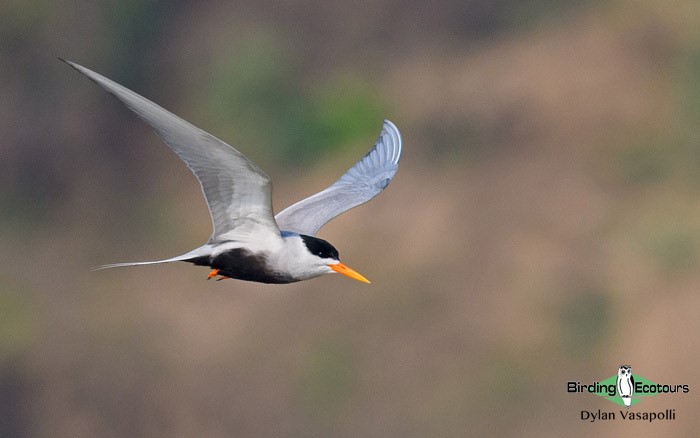
Day 6. Travel between Koshi Tappu Wildlife Reserve and Chitwan National Park
This will essentially be a travel day, as we drive through some beautiful landscapes for the full day between Koshi Tappu Wildlife Reserve and Chitwan National Park. We will break up the long journey along the way by looking for the highly sought, stunning, unique, and monotypic Ibisbill, sure to be a trip highlight. While looking for the Ibisbill we may also find Wallcreeper (another monotypic target), White-capped Redstart, Plumbeous Water Redstart, Spotted Forktail, Little Forktail, and Brown Dipper among the huge boulders along the rivers.
Overnight: Chitwan
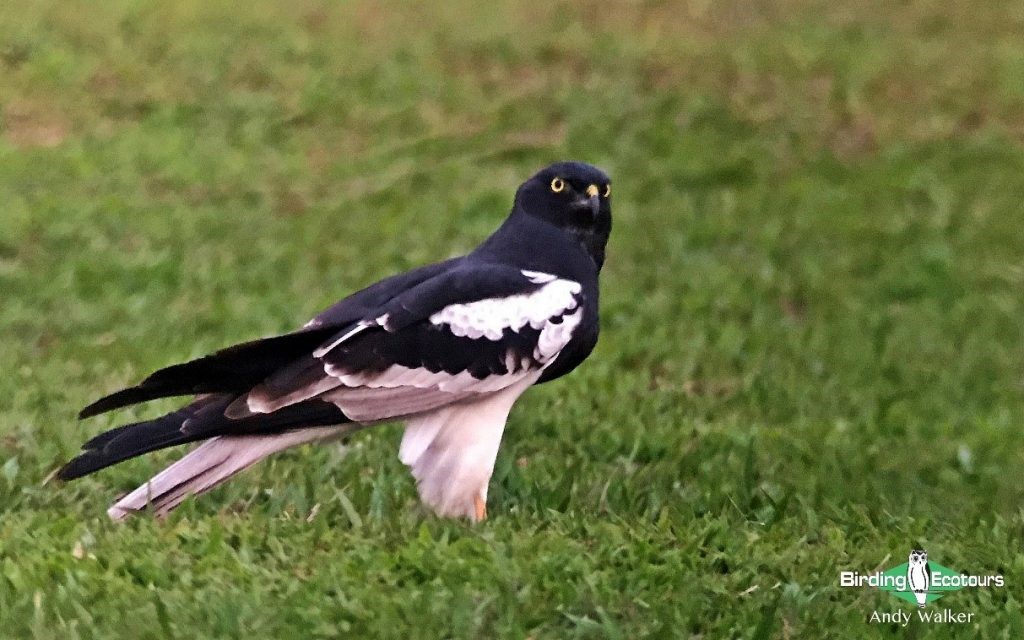
Days 7 – 8. Chitwan National Park
Chitwan is Nepal’s oldest national park, and it conserves the largest tract of threatened lowland Terai grasslands and subtropical forests, dominated by sal trees (Shorea robusta), in Nepal. Chitwan is home to a wide variety of other forest and grassland specials. These include species like Indian Grassbird, Bristled Grassbird, Jerdon’s Babbler, Slender-billed Babbler (the best place on the Indian subcontinent for this species), White-tailed Stonechat, Black-breasted Weaver, Barred Buttonquail, Rosy Pipit, and the hulking Lesser Adjutant. We will also have to be on the lookout for the skulking, yet breathtakingly beautiful Himalayan Rubythroat as we make our way around suitable scrub habitat.
The sal forests and forest edges are home to a plethora of exciting specials, including a diversity that ranges from the tiny White-browed Piculet to the sizeable and noisy Red Junglefowl and Indian Peafowl. The forest edge provides a great location from which to spot the strikingly large and colorful Great Hornbill as well as Red-headed Trogon, Green-billed Malkoha, and the spectacular Common Green Magpie. Visitors to Chitwan are typically impressed by the abundance and diversity of amazingly colored woodpeckers, which include Himalayan Flameback, Greater Flameback, and Black-rumped Flameback as well as both Lesser Yellownape and Greater Yellownape among a host of others (see below). We may also find the vociferous pair of Greater Necklaced Laughingthrush and Lesser Necklaced Laughingthrush as they move through the woodland in large and marauding flocks. Other birds that we will be on the lookout for in the woodlands here include Slaty-headed Parakeet, Red-breasted Parakeet, Fulvous-breasted Woodpecker, Streak-throated Woodpecker, Grey-headed Woodpecker, Black-backed Forktail, Orange-bellied Leafbird, Golden-fronted Leafbird, Ashy Bulbul, Yellow-eyed Babbler, Lesser Racket-tailed Drongo, Blue-eared Kingfisher, Blue-bearded Bee-eater, and Sultan Tit.
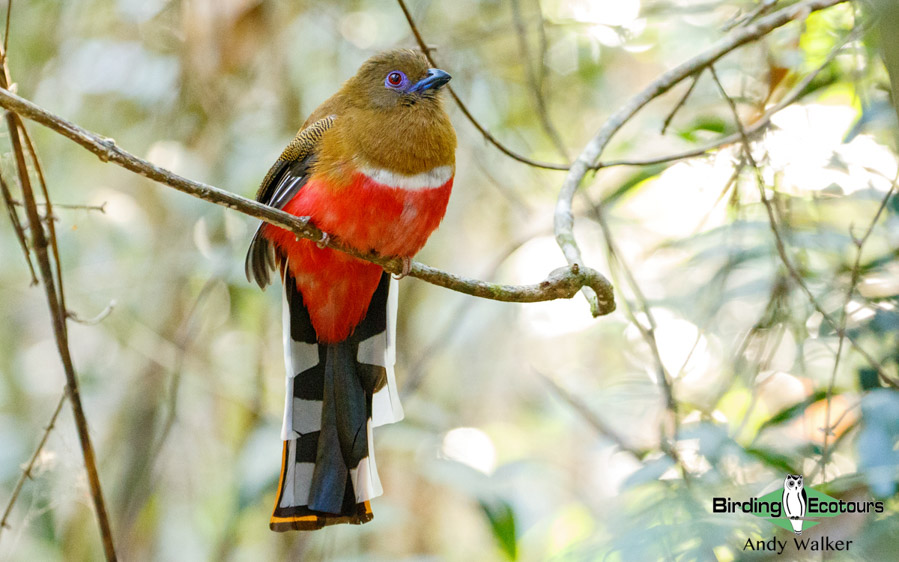
Chitwan is a raptor mecca, and during our visit we may encounter the boldly marked Crested Serpent Eagle, the petite Collared Falconet (don’t let its ‘cute’ appearance fool you – this is a rampant killing machine!), the striking Black Baza, Mountain Hawk-Eagle, and Grey-headed Fish Eagle. As dusk approaches our owl sightings may include Brown Fish Owl, Brown Wood Owl, and Brown Hawk-Owl, as well as the smaller Jungle Owlet and Oriental Scops Owl.
In Chitwan we will not only be searching for birds, because Chitwan is also home to most of Nepal’s remaining Greater One-horned (Indian) Rhinoceros and Bengal Tigers, both amazing and much-sought creatures. Chitwan also hosts two species of crocodiles – Mugger and Gharial – and plenty of other great mammals such as Indian Leopard, Sloth Bear, Asian Elephant, Chinese Pangolin, Golden Jackal, and Gaur.
The huge assortment of quality birds, mammals, and reptiles all combine to make this a great place for any wildlife enthusiast or nature photographer to visit.
Overnight: Chitwan
Day 9. Travel between Chitwan National Park and Bardia National Park
Facing essentially a travel day we reluctantly leave Chitwan National Park and commence our journey to Bardia National Park in the southwest of the country. Bardia is the largest lowland sanctuary and the most-undisturbed wilderness area of Terai, and we will check into our accommodation for the next few nights.
Overnight: Bardia
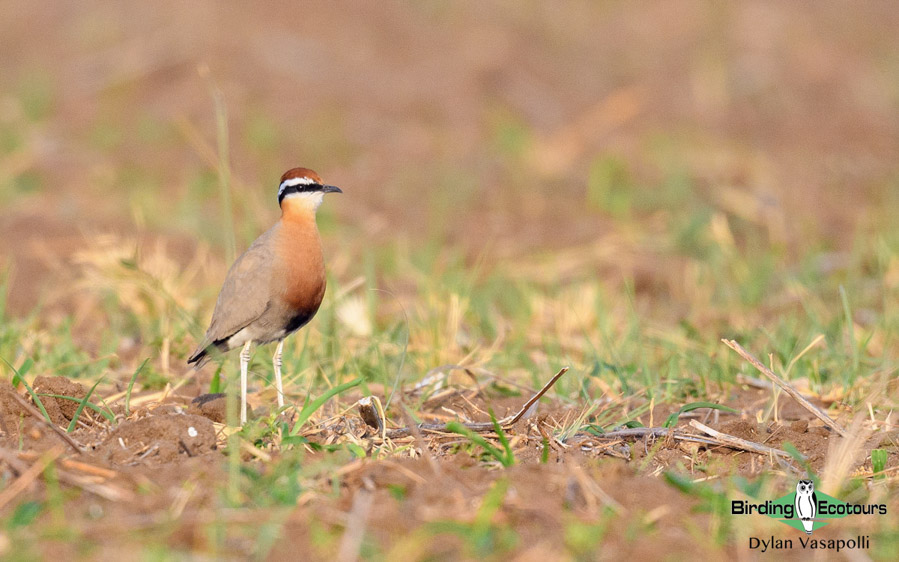
Days 10 – 11. Bardia National Park
A huge number and wide range of species are possible at Bardia National Park. High-quality birds we could find during our time here including Sarus Crane, Swamp Francolin, Sirkeer Malkoha, Yellow-footed Green Pigeon, Lesser Adjutant, Black Stork, Painted Stork, Black-necked Stork, Red-naped Ibis, Oriental Darter, Indian Courser, Black-bellied Tern, Dusky Eagle-Owl, Red-headed Vulture, White-rumped Vulture, Slender-billed Vulture, Indian Spotted Eagle, Great Hornbill, Great Slaty Woodpecker, White-naped Woodpecker, Yellow-crowned Woodpecker, Maroon Oriole, Short-billed Minivet, Rosy Minivet, Small Minivet, Black-headed Jay, Bengal Bush Lark, Tawny-bellied Babbler, Striated Babbler, Chestnut-tailed Starling, Brahminy Starling, Grey-winged Blackbird, Tickell’s Thrush, Slaty-backed Forktail, Blue-capped Rock Thrush, and White-tailed Stonechat.
The wide range of habitats here also provides excellent opportunities for finding some interesting reptiles and mammals, the three big targets here being Greater One-horned (Indian) Rhinoceros, Bengal Tiger, and Ganges River Dolphin. Other non-avian highlights might include Gharial, Mugger, Asian Elephant, and Swamp Deer.
Overnight: Bardia
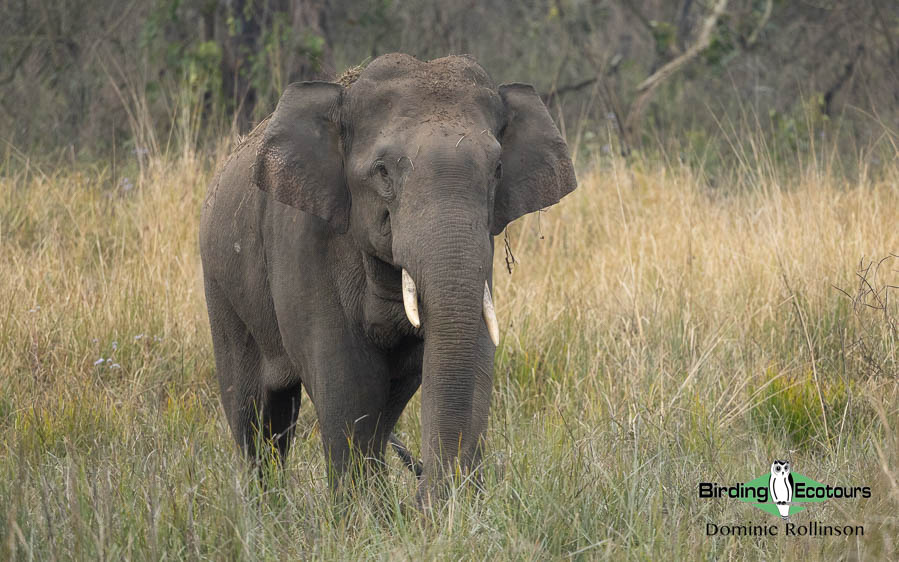
Day 12. Travel between Bardia National Park and Nepalgunj, flight to Kathmandu
We will leave the Bardia National Park area and drive to Nepalgunj, where we will catch a flight back to Kathmandu for the final group evening meal of the tour.
Overnight: Kathmandu
Day 13. Departure from Kathmandu, tour concludes
The tour concludes with your international departure from Kathmandu.
Overnight: Not included
Please note that the itinerary cannot be guaranteed as it is only a rough guide and can be changed (usually slightly) due to factors such as availability of accommodation, updated information on the state of accommodation, roads, or birding sites, the discretion of the guides and other factors. In addition, we sometimes have to use a different guide from the one advertised due to tour scheduling and other factors.
Download Itinerary
